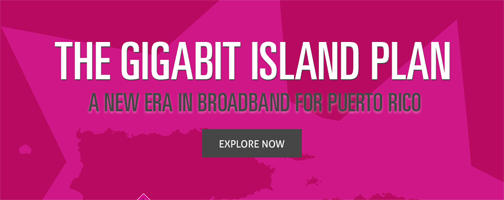Experts: Broadband use should be economic indicator


“Over the past two years, we have made great strides in speed and penetration of broadband Internet,” said Telecommunications Regulatory Board President Javier Rúa-Jovet during the presentation of the “Gigabit Island Plan.”
Puerto Rico needs to consider integrating broadband use as one of its key economic indicators — beyond cement production and energy consumption — to promote business expansion and the development of new initiatives to create jobs, generate tax revenue and even increase real estate values, public and private sector industry representatives said Tuesday.
During an event hosted by the government’s Chief Information Officer, the Puerto Rico Broadband Taskforce laid out its “Gigabit Island Plan,” which evaluates the state of broadband in Puerto Rico and examines strategies to accelerate broadband expansion across the island.
Raquel Noriega, vice president of public policy for Connected Nation — a component of the public-private partnership that comprises the Puerto Rico Broadband Task Force — said the island should contemplate “transforming its economic indicators, which are based on data from the past” to bring broadband use into the loop.
“Measuring cement production and use is less relevant each time not only to understand what’s happening, but what will happen in a few years,” she said. “Including broadband as an indicator will not only be important for the development of broadband companies and companies that want to invest in Puerto Rico, but to promote the island as a place where the knowledge economy is working well.”
Incorporating this type of data is included in the “Gigabit Island Plan” to address the island’s need to measure data traffic use, which it could use to produce statistics, she said.
“In Puerto Rico, the relevance of this technology represents an opportunity to offer services of all kinds to clients in Brazil, Spain, the U.S. mainland, or wherever, and it’s an extremely important opportunity we should not let pass us by,” Noriega said.
The “Gigabit Island Plan” released Tuesday outlined several network connectivity goals to be achieved in the coming years, including:
- By 2018, 90 percent of Puerto Rico households will have access to broadband download speeds of 10 Mbps. By 2020, 99 percent of households will have access to that network capacity.
- By 2018, 50 percent of Puerto Rico households will have access to broadband download speeds of 1Gbps. By 2020, 70 percent of households will have access to that network capacity.
To achieve those goals, the group laid out a few recommendations, namely, to continue and expand islandwide broadband mapping; monitor, measure, and assess the impact of broadband across the Puerto Rico economy; lower the costs of broadband build-out through community and provider collaboration; promote public-private partnerships to stimulate local demand and expand market opportunities; leverage federal support for broadband expansion; and stimulate broadband adoption to encourage further investment.
“The strategic plan is only the beginning of the process of expanding broadband access and adoption, or expanding its use across the island. This process will require different coordination and interagency adjustments, at the government and private sector levels,” CIO Giancarlo González said Tuesday.
“If the island wants to attract more investment, incorporate innovative practices to its educational system and increase the value of real estate, it is essential to increase our bandwidth capacity,” he said.
“This has shown to be an economic engine for various economies around the world. Example of this are the cities of Kansas and Chattanooga in the U.S. mainland, whose economies grew from 1 percent to 2 percent above the average by increasing their ability to throw at speeds Giga,” González noted.
According to the Puerto Rico Planning Board, Puerto Rico’s information technology sector has experienced an annual growth of 3.8 percent and accounted for $2.6 billion (2.5 percent) of the Gross Domestic Product in 2013, surpassing other industries such as construction, which accounted for about $1.4 billion.










